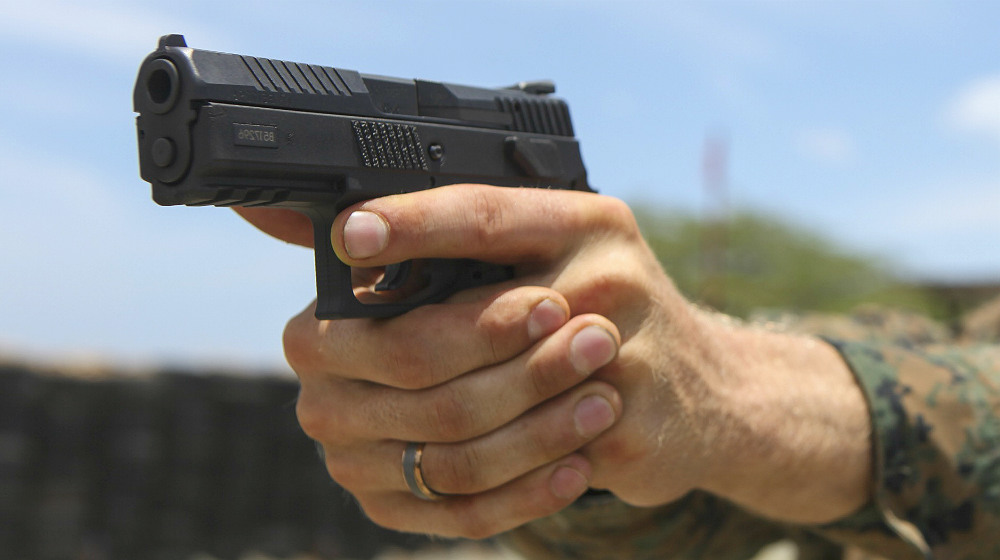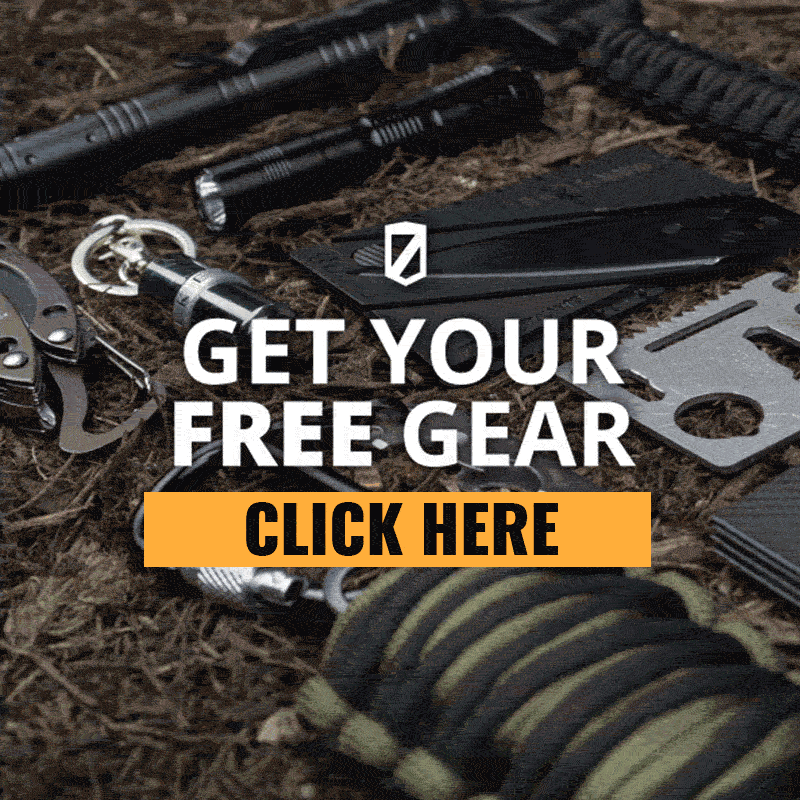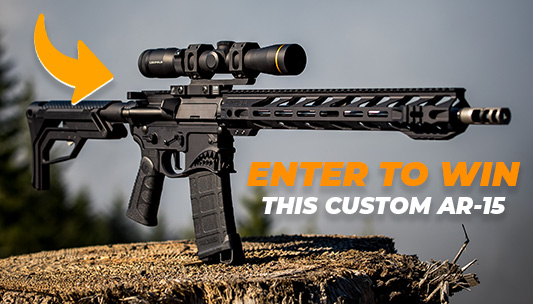Tips & Tricks
How To Properly Fit A Handgun To Your Hand
Published
2 years agoon
By
Eve Flanigan
If you want to shoot better, you'll need to know how to properly fit a handgun to your hand. There's just no way around it. After all, no matter how amazing your gun is on paper, if you're not comfortable using it, then there's no way you'll be able to perform at your peak.
How to Properly Fit A Handgun to Your Hand: Improve Your Shooting Skills
Safety Advisory
Before you do anything outlined here, it is imperative that you UNLOAD your firearm first and check it again a second time to ensure that there are no bullets left in it. And, since you will be doing some dry firing, be sure to keep the muzzle from covering anything you're not willing to destroy.
1. Start With Your Shooting Hand
When you pick any handgun up, make sure the “V” between your thumb and forefinger are as high up as they can reasonably go on the backstrap. Not only is it a great way to get a feel for the firearm, but also the perfect position to properly fit a handgun.
Things to consider:
- There should be no gap between your hand and the rearward curve or beavertail on most semi-autos.
- If it’s a revolver, it should have an indentation or some sort of texture to show the ideal place for the “V” of your hand.
2. Keep The Grip Centered

The finger should touch the trigger and not the trigger guard when testing or firing.
The goal here is to hold the gun in your shooting hand without letting any part of it rest on anything—not even your support hand. Place, if you can, the center of the distal pad of your trigger finger over the center of the trigger, but don’t allow it to touch the trigger guard. If the trigger is really long, you can move your finger to its lower half to make the pull easier, provided you still don’t end up touching the trigger guard.
Some semi-auto triggers have safety levers that need to be pressed for them to work. If the gun you’re trying out has such a lever, then you'll have to do this test with the lever pressed flush against the face of the trigger. Just be sure to not take up slack on the trigger itself or you may not be able to properly fit a handgun.
3. Pause and Observe

Lots of clearance between finger and gun.
With your grip centered and finger placed correctly on the trigger, look at the rest of your trigger finger, viewing your hand and gun from the top.
Ideally, there should be a shallow C-shaped curve in your finger, with some air between the palmar surface of your finger and the frame of the gun. If the gun’s a bit too small for your hand, you'll most likely end up hooking too much of your finger across the trigger guard and around the trigger (as seen in the cover photo). If the gun’s a bit too big, on the other hand, you should still be able to reach the trigger, but your finger will be flat against the frame. Finally, if the gun’s way too big for you, then you’ll find yourself rotating the “V” of your hand toward the trigger to reach it.
4. Press The Trigger Slowly
A proper trigger press is a steady and straight motion rearward. Take your time and repeat this step several times to ensure you're able to do it correctly using the gun you're testing.
5. Evaluate The Fit

This HK is just a bit too long from backstrap to trigger, so…

…by slightly rotating my grip to the right, I create a clearance between my finger and the trigger.
If you're able to hold the gun the way outlined in step 3, then this step should confirm that you have the perfect fit. Keep in mind, however, that there are some instances where an individual’s bone structure, injury history or medical conditions create exceptions. In most cases, though, this should be the final step in checking for proper gun fit.
If your trigger finger is too long for the gun, you'll need to make larger “C” to ensure that the center of your finger pad lands on the center of the trigger. Otherwise, you'll end up hooking too much of your finger across the trigger. Doing so will pull your shots in the direction of your trigger hand.
But what if your trigger finger is too short to reach the trigger with the web of hand centered on the backstrap? If this is the case, then you'll have to check if you can rotate your hand slightly to achieve a bit of air between your finger and the frame but still manage a secure grip and good trigger press. This is because without it, your shots will go opposite the direction of your firing hand. In other words, if you're right-handed you'll end up pushing your shots to the left.

This full-size 1911 requires that I squish my finger flat against the gun just to reach the trigger. A poor fit.
6. Do What Is Comfortable
It's now time to make a decision. Again, ideally, you'd want a gun that fits your hand perfectly. However, even if the gun you want doesn't, you could still make do with it, provided you're willing to compensate by adjusting your grip. At the end of the day, if you can make a gun work even if it's supposed to not feel right in your hands, then it's all good.
7. Consider Workarounds
Another reason people go with uncomfortable gun sizes is that they simply have no choice. Gun owners who want something easy to conceal, for instance, must make do with smaller guns. You can't very well tote an AR-15 around. Police officers, on the other hand, need to use whatever firearm is assigned to them. The good news is that there are certain hacks that can be used to make uncomfortable guns work better.
For example, wider grips or rubber sleeves can be installed on guns that are too small to make them easier to hold. This will make it very hard to properly fit a handgun. For guns that are just a tad too big, on the other hand, again, a quick fix is to simply rotate the shooting hand a bit toward the trigger. To make things even easier, however, you can also do a two-handed grip where the heel of the support hand rests on that of the shooting hand, keeping no part of the grip visible. Unfortunately, if the gun is so big that you're forced to rotate you shooting hand in a way that the bottom joint of the thumb ends up in the path of the beavertail or posterior bulge, there's really not much you can do. Your best bet is to just move on to a different firearm.
When it comes to mechanical workarounds, however, few can beat the adjustable grip systems that come with guns like Generation 4 Glocks, the Heckler & Koch VP series and Canik TP9s. These firearms are shipped with several different grips so you can choose the one that fits your hand best. They're perfect of law enforcement officers because they can be customized for maximum comfort without compromising the uniform look police departments typically go for.
Looking for more ways to improve as a shooter? Once you know how to properly fit a handgun, watch this video from Chris Sajnog and learn how to focus on your front sight!
It’s definitely easier shoot well by choosing a gun that fits in the first place. But where there’s a will, there’s a way. I’ve seen people who own a particular model practice enough to shoot it well despite a poor fit. In fact, I’m one of them, having hands that are too small for most full-size pistols.
How did differences in grip sizes affect your choice of guns and overall development as a shooter? Tell us in the comments section below!
Up Next: The 7 Best Handguns for the New Shooter
Follow us on Facebook, Instagram, Twitter, and Pinterest!
Editor’s Note – This post was originally published in May 2016 and has been updated for quality and relevance.
Originally posted on June 5, 2018 @ 9:00 AM


Handgun Designs: From Historic Flintlocks to Modern Innovations

Cleaning Firearms Made Easy: Post-Holiday Range Tips for Gun Owners

Training Resolutions for 2025: Unlock Your Potential

Winter Dressing for Concealed Carry: Stay Warm and Armed

Best New Guns of 2024: Innovations for Every Shooter

2024 Gun Legislation: What Passed, What Failed, and Why It Matters




NolanR
April 13, 2017 at 10:36 PM
Wendell is correct!
Wendell
April 13, 2017 at 3:43 PM
How can anybody comment? With all the shit u put on the screen u can’t read the article.
Gus Kaubisch
May 10, 2016 at 10:08 AM
Due to injury to my shooting hand, I don’t have a firm grip on some pistols. Are you aware of any company that would make a slip on grip from a hand imprint similar to how they make in ear hearing aids?
Wayne Buck
May 7, 2016 at 4:55 PM
I didn’t see jack shit about revolvers ! What do you think,everyone carries a semi-auto? You got life messed up ! If you,re going to give advice, you might want to give it correctly !
Johnny Cache
July 29, 2016 at 12:16 AM
Hi Wayne. Your logic is flawed. The article didn’t say anything about revolvers, that doesn’t mean the writer has life messed up. Maybe they don’t like revolvers so they chose to write about something they do like. Maybe they were not as confident about their advice with revolvers so they stuck to what they knew.
What advice did they give that was incorrect? Was it just incorrect because it wasn’t about something you wanted to hear about? So what. Is it that big of a deal? Either way bravo. I am sure your comments didn’t really help newbies want to run out and buy a revolver.
George Steele
May 7, 2016 at 11:37 AM
A new member of a local police force came to our range as a guest of a friend of mine. He was complaining about the duty pistol he had been issued – light weight, and .45. He printed a few targets, and the shots were all over the place – horizontally in particular. I suggested he try my S&W 4006 in .40 S&W; same problem. I looked at his grip, and he was arching his trigger finger properly, but also the other fingers of his hand, as well as his palm, so there was space between palm and grip.
I suggested that he start his grip by grasping the front strap, and then rotating the grip into his hand, finally wrapping his thumb around the left side. That put some tension across the skin of his palm, and anchored the pistol (the 4006 has a stippled front strap). Firing one-handed, the next target was minor vertical stringing and perhaps a half inch horizontal – from what had been 4+ inches with his original grip. Using a two-hand, modified Weaver stance, the vertical string went away as well. He was stunned at the difference the grip and stance had made, because he had been struggling for weeks to qualify – with young eyes, yet. Grip matters.